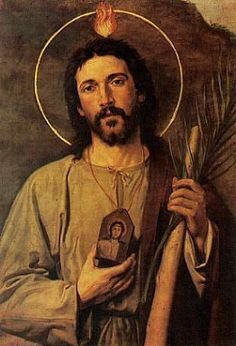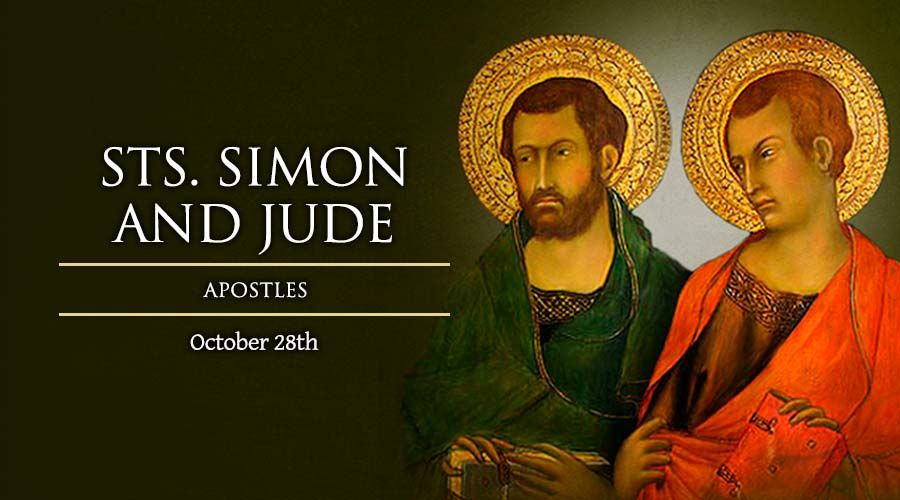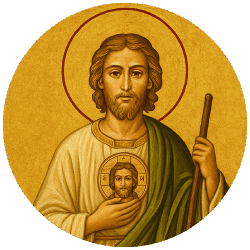Who is St. Jude?
St. Jude is the much beloved patron Saint of our parish. He’s the patron saint of hopeless or impossible causes. But what else do we know about him? And why does he share a feast day with St. Simon?
Saint Jude, known as Thaddaeus, was a brother of Saint James the Less, and a relative of Our Savior. He was one of the 12 Apostles of Jesus and his attribute is a club (the means of his martyrdom). Images of Saint Jude often include a flame above his head, which represents his presence at Pentecost, when he accepted the Holy Spirit alongside the other apostles. Another attribute is Saint Jude holding an image of Christ, in the Image of Edessa (as seen in our own shrine). Sometimes he can also be seen holding a carpenter’s ruler or is depicted with a scroll or book, the Epistle of Jude.
Biblical scholars agree Saint Jude was a son of Clopas and his mother Mary was the Virgin Mary’s cousin. Ancient writers tell us that he preached the Gospel in Judea, Samaria, Idumaea, Syria, Mesopotamia, and Lybia. According to Eusebius, he returned to Jerusalem in the year 62, and assisted at the election of his brother, Saint Simeon, as Bishop of Jerusalem.

Saint Jude is not the same person as Judas Iscariot, who betrayed Our Lord and despaired because of his great sin and lack of trust in God’s mercy.
Jude was the one who asked Jesus at the Last Supper why He would not manifest Himself to the whole world after His resurrection (John 14:22–23). Little else is known of his life. Legend claims that he visited Beirut and Edessa and could have been martyred with Saint Simon in Persia.
He is an author of an epistle (letter) to the Churches of the East, particularly the Jewish converts, directed against the heresies of the Simonians, Nicolaites, and Gnostics. There is some debate about where Jude died, though most Biblical scholars agree he was martyred. He is believed to have been martyred either in Armenia or Beirut.
Following his death, Saint Jude’s body was brought to Rome and left in a crypt in St. Peter’s Basilica. Today his bones can be found in the left transept of St. Peter’s Basilica under the main altar of St. Joseph in a tomb he shares with the remains of the apostle Simon the Zealot.
Pilgrims came to Saint Jude’s grave to pray and many reported a powerful intercession, leading to the title, “The Saint for the Hopeless and the Despaired.” Two Saints, St. Bridget of Sweden and St. Bernard, had visions from God asking them to accept St. Jude as “The Patron Saint of the Impossible.”
Catholics invoke Saint Jude when in desperate situations because his New Testament letter stresses that the faithful should persevere in the environment of harsh, difficult circumstances – just as their forefathers had done before them; therefore, he is the patron saint of desperate cases.
There are two mentions of Jude in the New Testament: Luke 6:16 and Acts of the Apostles 1:13.
When the apostles are listed in Matthew 10:3 and Mark 3:18, Jude’s name does not appear but “Thaddeus” does. This occurrence led early Christians to believe Jude was known as both “Jude” and “Thaddeus,” the latter of which could have been a sort of nickname.
Is Jude the Apostle the brother of Jesus?
In the letter he wrote St. Jude calls himself a servant of Christ and brother of James (Jude 1:1). Other texts have suggested to some that he was a brother of Jesus, along with James, Joses (Joseph) and Simon. From its beginning the Church believed that only Jesus our High Priest ever entered the Holy of Holies of His Mother’s womb, a doctrine called Her Perpetual Virginity. The Jewish reverence for the Ark, the Temple, the Sanctuary, and the Holy of Holies were a mere foreshadowing of the reality of the Incarnation, in which the Word would take flesh from Woman and dwell among us.
For this reason, the Church sought other explanations for the brothers of Jesus in both the Gospel text and the practice of Israel. The simplest is linguistic. The Greek word “adelphoi” used in the New Testament is equivocal, and can refer to blood brothers, other close male relatives but also spiritual kindship. A Jew was a member of a family, a tribe and Israel. We have similar usages today, both culturally and in the Church, where we are all brothers and sisters in Christ.
The other explanation is that Joseph was a widower with children, and these were the brothers and sisters of the Lord. However, if this were true, then the fact that from the Cross Jesus entrusted His Mother to John, a non-brother, remains a puzzling contradiction.
Both explanations have in common, however, that Jesus had no blood brothers, since Mary bore only one Child, the Word-made-flesh, and together, Mother and Son, fulfilled all the foreshadowing of the Old Covenant with respect to this sublime mystery.
How was St. Jude martyred?
One account has St. Jude being martyred by axe or spear while preaching together with St. Simon in Persia. Another account states he was martyred in Beirut, in Lebanon, by axe. The common element is the axe, which, in fact, became a symbol associated with Jude Thaddeus.
What can we learn from St. Jude?
Pope Benedict XVI taught:
[W]ith regard to Jude Thaddaeus, this is what tradition has called him, combining two different names: in fact, whereas Matthew and Mark call him simply “Thaddaeus” (Mt 10: 3; Mk 3: 18), Luke calls him “Judas, the son of James” (Lk 6: 16; Acts 1: 13).
The nickname “Thaddaeus” is of uncertain origin and is explained either as coming from the Aramaic, taddà’, which means “breast” and would therefore suggest “magnanimous”, or as an abbreviation of a Greek name, such as “Teodòro, Teòdoto”.
Very little about him has come down to us. John alone mentions a question he addressed to Jesus at the Last Supper: Thaddaeus says to the Lord: “Lord, how is it that you will manifest yourself to us and not to the world?”
This is a very timely question which we also address to the Lord: why did not the Risen One reveal himself to his enemies in his full glory in order to show that it is God who is victorious? Why did he only manifest himself to his disciples? Jesus’ answer is mysterious and profound. The Lord says: “If a man loves me, he will keep my word, and my Father will love him, and we will come to him and make our home with him” (Jn 14: 22-23).
This means that the Risen One must be seen, must be perceived also by the heart, in a way so that God may take up his abode within us. The Lord does not appear as a thing. He desires to enter our lives, and therefore his manifestation is a manifestation that implies and presupposes an open heart. Only in this way do we see the Risen One.
What can we learn from St. Jude’s Epistle?
Pope Benedict XVI taught:
The paternity of one of those New Testament Letters known as “catholic,” since they are not addressed to a specific local Church but intended for a far wider circle, has been attributed to Jude Thaddaeus. Actually, it is addressed “to those who are called, beloved in God the Father and kept for Jesus Christ” (v. 1).
A major concern of this writing is to put Christians on guard against those who make a pretext of God’s grace to excuse their own licentiousness and corrupt their brethren with unacceptable teachings, introducing division within the Church “in their dreamings” (v. 8).
This is how Jude defines their doctrine and particular ideas. He even compares them to fallen angels and, mincing no words, says that “they walk in the way of Cain” (v. 11).
Furthermore, he brands them mercilessly as “waterless clouds, carried along by winds; fruitless trees in late autumn, twice dead, uprooted; wild waves of the sea, casting up the foam of their own shame; wandering stars for whom the nether gloom of darkness has been reserved for ever” (vv. 12-13).
Today, perhaps, we are no longer accustomed to using language that is so polemic, yet that tells us something important. In the midst of all the temptations that exist, with all the currents of modern life, we must preserve our faith’s identity. Of course, the way of indulgence and dialogue, on which the Second Vatican Counsel happily set out, should certainly be followed firmly and consistently.
But this path of dialogue, while so necessary, must not make us forget our duty to rethink and to highlight just as forcefully the main and indispensable aspects of our Christian identity. Moreover, it is essential to keep clearly in mind that our identity requires strength, clarity, and courage in light of the contradictions of the world in which we live.
Thus, the text of the Letter continues: “But you, beloved” – he is speaking to all of us -, “build yourselves up on your most holy faith; pray in the Holy Spirit; keep yourselves in the love of God; wait for the mercy of our Lord Jesus Christ unto eternal life. And convince some, who doubt…” (vv. 20-22).
The Letter ends with these most beautiful words: “To him who is able to keep you from falling and to present you without blemish before the presence of his glory with rejoicing, to the only God, our Saviour through Jesus Christ our Lord, be glory, majesty, dominion and authority, before all time and now and for ever. Amen” (vv. 24-25).
It is easy to see that the author of these lines lived to the full his own faith, to which realities as great as moral integrity and joy, trust and lastly praise belong, since it is all motivated solely by the goodness of our one God and the mercy of our Lord Jesus Christ.
Why do Sts. Simon and Jude share a feast day?
Sts. Simon and Jude were Apostles of the Lord Jesus Christ.
After many years of evangelizing after Jesus’ death and Resurrection, these men are said to have suffered martyrdom together after having gone as missionaries to Suanis, a city of Persia. Because of this, they are honored on the same day. The Church celebrates their feast day on October 28.
Why are Sts. Simon and Jude often mentioned together?
Simon and Jude are often mentioned together because they were companions in their mission of evangelization. They traveled together to preach the Eternal Word, Jesus Christ, to the nations, and are believed to have been martyred together on one of these missions which led them to be honored together on the same feast day.

Who is St. Simon?
St. Simon is referred to in Scripture by Matthew and Mark as the “Cananaean” and by Luke as “the Zealot.” Both titles mean the same, zealous for the Jewish Law, and distinguish him from Simon, whom the Lord renamed, Peter or Rock. It is unclear whether he belonged to the political party of that day, which was known as the Zealots, or was simply known for his religious zeal.
Simon the Zealot is a different man than Simon Peter. Similar to Judas Iscariot and Jude Thaddeus, Simon the Zealot and Simon Peter shared similarities in their name and are distinguished by titles given to them for this reason.
Simon Peter is the “rock” upon which Christ built His Church (Matthew 16:18). Simon the Zealot is a lesser-known Apostle, given the title of “zealot,” either because he was zealous in his faith, or if he belonged to the political group called the Zealots that was active at the time.
Were Simon and Jude brothers?
No, they were not brothers, though some may have this perception because of the way they are honored together and celebrated on the same feast day. Though they did not share the same mother and father, it would be fair to say that they shared a spiritual brotherhood in Christ, having lived and grown in their faith together among the other Apostles.
Source: EWTN
